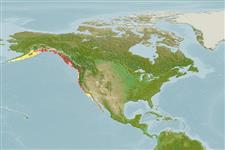Common names from other countries
Environment: milieu / climate zone / depth range / distribution range
Ecología
; rango de profundidad 0 - 90 m (Ref. 78177). Subtropical, preferred 9°C (Ref. 107945); 61°N - 30°N, 168°W - 116°W (Ref. 78486)
Distribución
Países | Áreas FAO | Ecosistemas | Ocurrencias, apariciones | Introducciones
Eastern Pacific: Nunivak and Kodiak Islands, Alaska to Isla San Martin, Baja California. Subtropical to temperate.
Length at first maturity / Tamaño / Peso / Age
Maturity: Lm ? range ? - ? cm Max length : 20.0 cm CW macho / no sexado; (Ref. 78486)
Depth range is from intertidal to about 90 m. Max size from male specimen captured off Punta Banda, Baja California (Ref. 78177). Forages on shores protected from wave action. Juveniles and mating pairs occur in the intertidal zone only on nocturnal high tides (Ref. 78483). Buries itself in the substrate during periods of inactivity (Ref. 78491). Excavating predator (Ref. 78493).
Life cycle and mating behavior
Madurez | Reproducción | Puesta | Huevos | Fecundidad | Larva
Most species produce a single brood each winter but may reach up to two or three broods per year and the reproductive life span is about 4 years. The cumulative number of broods produced over the maximum life span is about 4 broods.
Jensen, G.C. 1995. (Ref. 78177)
IUCN Red List Status (Ref. 130435)
CITES status (Ref. 108899)
Not Evaluated
Not Evaluated
Human uses
Pesquerías: comercial
FAO - pesquerías: landings | FishSource | Sea Around Us
Herramientas
Fuentes de Internet
Estimates based on models
Preferred temperature
(Ref.
115969): 8 - 12.1, mean 9.6 (based on 82 cells).
Vulnerability
Low vulnerability (10 of 100).
